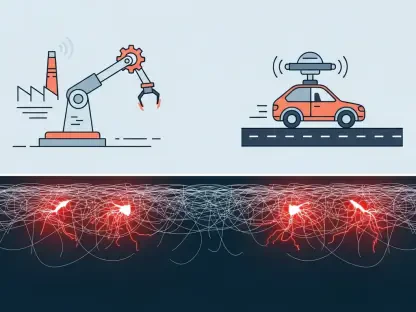The telecommunications industry stands at a pivotal moment, where the once-static networks that connected calls and data are rapidly transforming into dynamic, intelligent systems powered by artificial intelligence. This shift is not merely a technological upgrade but a fundamental reimagining of how networks operate, predict, and respond to challenges. With the explosion of data traffic and the growing complexity of user demands, operators are under immense pressure to deliver seamless connectivity and reliability. AI-driven systems offer a solution by enabling networks to anticipate issues before they arise, optimize resources in real time, and reduce human intervention through automation. This evolution promises to redefine service delivery, ensuring that disruptions become a rarity rather than the norm, while also paving the way for innovative customer experiences in an increasingly connected world.
The Journey to Intelligent Network Management
Detecting Anomalies with Precision
The foundation of intelligent telecommunications networks lies in their ability to detect potential problems before they impact users, marking a significant departure from traditional reactive approaches. Advanced monitoring tools, coupled with streaming telemetry, play a crucial role in identifying anomalies through predictive analytics. Techniques such as threshold-crossing alarms and trend prediction allow operators to sift through vast data streams, distinguishing between harmless fluctuations and genuine threats. By leveraging AI, these systems aggregate statistical data to establish performance baselines and spot outliers with remarkable accuracy. This early detection provides operators with critical lead time to address issues, preventing service disruptions and enhancing overall reliability. The emphasis on proactive intervention reflects a broader industry shift toward anticipating user needs rather than merely responding to complaints.
This detection phase is further refined by AI’s capacity to learn from historical patterns, continuously improving its ability to identify subtle deviations that might signal impending failures. Unlike older systems that relied heavily on manual oversight, modern networks use machine learning algorithms to adapt to evolving conditions, ensuring that even the smallest irregularities are flagged for review. Such precision minimizes false positives, which can overwhelm operational teams and waste resources. As a result, telecommunications providers can maintain higher service standards while reducing operational costs. This focus on early intervention not only boosts customer satisfaction but also sets the stage for deeper analysis and strategic planning, ensuring networks remain resilient in the face of growing complexity and demand.
Analyzing Utilization for Strategic Growth
Once anomalies are detected, the next step in network intelligence involves analyzing utilization patterns to optimize performance and plan for future growth. Digital twins—virtual replicas of physical networks—enable operators to conduct detailed “what-if” scenarios, testing potential expansions or upgrades without risking real-world disruptions. This analytical approach helps in fine-tuning resource allocation, ensuring that bandwidth is distributed fairly during peak usage times based on historical data insights. Beyond operational efficiency, such analysis transforms raw data into actionable business intelligence, allowing for personalized service offerings and targeted marketing strategies that align with user behavior.
The strategic value of real-time analysis cannot be overstated, as it empowers operators to make informed decisions that enhance quality of service while meeting rising customer expectations. By simulating network conditions, providers can anticipate bottlenecks and address them proactively, ensuring consistent performance even under strain. This data-driven mindset also supports long-term planning, enabling companies to scale infrastructure in alignment with projected demand. As a result, the industry is witnessing a shift toward smarter, more adaptive networks that prioritize user experience through meticulous planning and resource management, setting a new standard for operational excellence.
Automation and the Future of Operations
Assisting Human Operators with Smart Tools
The pinnacle of network intelligence is reached through automation, where AI systems assist human operators by streamlining complex tasks and reducing resolution times. Automated troubleshooting mechanisms can identify and address issues with consistency, minimizing the variability often seen in manual processes. By integrating live operational data with predictive insights from digital twins, these systems offer actionable recommendations that enhance decision-making. Enhanced interfaces, such as intuitive chatbots and data visualizations, further simplify problem resolution, allowing teams to focus on strategic priorities rather than routine maintenance.
Beyond immediate problem-solving, automation plays a vital role in managing the sheer volume of data generated by modern networks, ensuring that critical information is prioritized and acted upon swiftly. This capability is particularly crucial as network complexity continues to grow with the integration of new technologies and services. By reducing the cognitive load on operators, intelligent automation fosters a collaborative environment where human expertise is complemented by machine precision. This synergy not only improves operational efficiency but also positions telecommunications providers to innovate at a faster pace, meeting market demands with agility.
Building a Cycle of Continuous Improvement
Automation does not operate in isolation but forms part of a continuous improvement cycle that integrates detection and analysis into a cohesive strategy. As detection identifies potential issues, analysis optimizes resource use, and automation refines responses, each phase informs and enhances the others, creating a self-reinforcing loop of efficiency. This holistic approach shifts network operations from a reactive stance to a proactive, data-driven discipline, ensuring that systems evolve in tandem with user needs and technological advancements. Such integration is essential for maintaining competitiveness in a landscape defined by rapid change.
This cyclical process also underscores the transformative potential of AI in telecommunications, where every interaction and data point contributes to refining network performance over time. Operators can thus anticipate challenges with greater accuracy, allocate resources more effectively, and automate routine tasks with confidence. The result is an infrastructure that not only meets current demands but is also prepared for future complexities. By embracing this integrated model, the industry has laid the groundwork for networks that are not just intelligent but truly adaptive, marking a significant milestone in the evolution of connectivity.
Reflecting on a Smarter Network Era
Looking back, the transformation of telecommunications networks into AI-driven systems proved to be a defining chapter in the industry’s history. The structured progression through anomaly detection, strategic utilization analysis, and intelligent automation reshaped how operators managed complexity and delivered value to users. These advancements addressed critical challenges of reliability and efficiency, setting a benchmark for what proactive management could achieve. Moving forward, the focus should center on scaling these intelligent systems to accommodate emerging technologies and even greater data demands. Exploring partnerships between technology providers and operators could accelerate innovation, while investing in workforce training ensures human expertise keeps pace with automation. This journey, though already impactful, highlighted the need for ongoing adaptation, urging the industry to remain agile and forward-thinking in harnessing AI’s full potential for the next wave of connectivity challenges.









